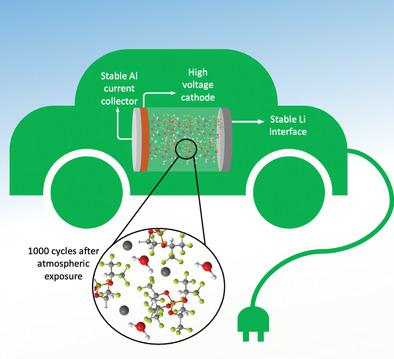当前位置:
X-MOL 学术
›
Adv. Energy Mater.
›
论文详情
Our official English website, www.x-mol.net, welcomes your
feedback! (Note: you will need to create a separate account there.)
Lithium Borate Ester Salts for Electrolyte Application in Next-Generation High Voltage Lithium Batteries
Advanced Energy Materials ( IF 24.4 ) Pub Date : 2021-08-14 , DOI: 10.1002/aenm.202101422 Binayak Roy 1 , Pavel Cherepanov 1 , Cuong Nguyen 1 , Craig Forsyth 1 , Urbi Pal 2 , Tiago Correia Mendes 2 , Patrick Howlett 2 , Maria Forsyth 2 , Douglas MacFarlane 1 , Mega Kar 1
Advanced Energy Materials ( IF 24.4 ) Pub Date : 2021-08-14 , DOI: 10.1002/aenm.202101422 Binayak Roy 1 , Pavel Cherepanov 1 , Cuong Nguyen 1 , Craig Forsyth 1 , Urbi Pal 2 , Tiago Correia Mendes 2 , Patrick Howlett 2 , Maria Forsyth 2 , Douglas MacFarlane 1 , Mega Kar 1
Affiliation

|
The atmospheric instability and the corrosive tendency of hexafluorophosphate [PF6]− and fluorosulfonylimide [FSI]− based lithium salts, respectively, are among the major impediments towards their application as electrolytes in high voltage lithium batteries. Herein a new class of Li salts is introduced and their electrochemical behavior is explored. The successful synthesis and characterization are reported, including the crystal structure, of lithium 1,1,1,3,3,3-(tetrakis)hexafluoroisopropoxy borate (LiBHfip). The oxidative stability of electrolytes of this salt in an ethylene carbonate:dimethyl carbonate mixture (v/v, 50:50) is found to be 5.0 V versus Li+/Li on various working electrodes, showing substantial improvement over a LiPF6 based electrolyte. Moreover, a high stability of an aluminum substrate is observed at potentials up to 5.8 V versus Li+/Li; in comparison, a LiFSI based electrolyte shows prominent signs of Al corrosion above 4.3 V versus Li+/Li. Cells tested with high voltage layered LiNi0.8Mn0.1Co0.1O2 (NMC811) and spinel LiMn2O4 (LMO) cathodes show stable cycling over 200 cycles with capacity retention of 76% and 90%, respectively. The LMO|Li cell maintains this same low capacity fade rate for 1000 cycles even after the salt has been exposed for 24 h to atmospheric conditions (water content ≈0.57 mass%).
中文翻译:

用于下一代高压锂电池电解质应用的硼酸锂酯盐
六氟磷酸盐[PF 6 ] -和氟磺酰亚胺[FSI] -基锂盐的大气不稳定性和腐蚀性分别是它们在高压锂电池中用作电解质的主要障碍之一。本文介绍了一类新的锂盐,并探索了它们的电化学行为。报道了 1,1,1,3,3,3-(四)六氟异丙氧基硼酸锂 (LiBHfip) 的成功合成和表征,包括晶体结构。发现这种盐的电解质在碳酸亚乙酯:碳酸二甲酯混合物 (v/v, 50:50) 中的氧化稳定性为 5.0 V 对 Li +/Li 在各种工作电极上,显示出比基于 LiPF 6的电解质有显着改进。此外,在高达 5.8 V 相对于 Li + /Li 的电位下观察到铝基板的高稳定性;相比之下,基于 LiFSI 的电解质在高于 4.3 V 与 Li + /Li 时显示出明显的 Al 腐蚀迹象。使用高压层状 LiNi 0.8 Mn 0.1 Co 0.1 O 2 (NMC811) 和尖晶石 LiMn 2 O 4测试的电池(LMO) 正极表现出超过 200 次循环的稳定循环,容量保持率分别为 76% 和 90%。即使盐暴露在大气条件下 24 小时(水含量≈0.57 质量%),LMO|Li 电池在 1000 次循环中仍保持相同的低容量衰减率。
更新日期:2021-09-23
中文翻译:

用于下一代高压锂电池电解质应用的硼酸锂酯盐
六氟磷酸盐[PF 6 ] -和氟磺酰亚胺[FSI] -基锂盐的大气不稳定性和腐蚀性分别是它们在高压锂电池中用作电解质的主要障碍之一。本文介绍了一类新的锂盐,并探索了它们的电化学行为。报道了 1,1,1,3,3,3-(四)六氟异丙氧基硼酸锂 (LiBHfip) 的成功合成和表征,包括晶体结构。发现这种盐的电解质在碳酸亚乙酯:碳酸二甲酯混合物 (v/v, 50:50) 中的氧化稳定性为 5.0 V 对 Li +/Li 在各种工作电极上,显示出比基于 LiPF 6的电解质有显着改进。此外,在高达 5.8 V 相对于 Li + /Li 的电位下观察到铝基板的高稳定性;相比之下,基于 LiFSI 的电解质在高于 4.3 V 与 Li + /Li 时显示出明显的 Al 腐蚀迹象。使用高压层状 LiNi 0.8 Mn 0.1 Co 0.1 O 2 (NMC811) 和尖晶石 LiMn 2 O 4测试的电池(LMO) 正极表现出超过 200 次循环的稳定循环,容量保持率分别为 76% 和 90%。即使盐暴露在大气条件下 24 小时(水含量≈0.57 质量%),LMO|Li 电池在 1000 次循环中仍保持相同的低容量衰减率。


















































 京公网安备 11010802027423号
京公网安备 11010802027423号